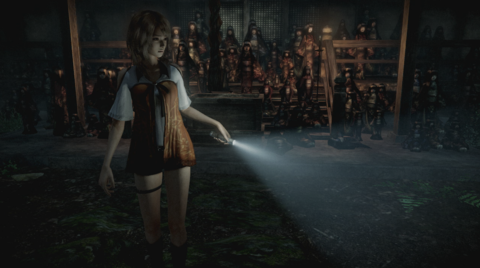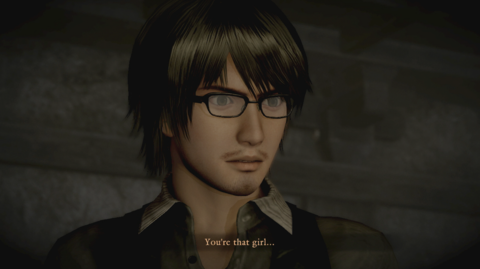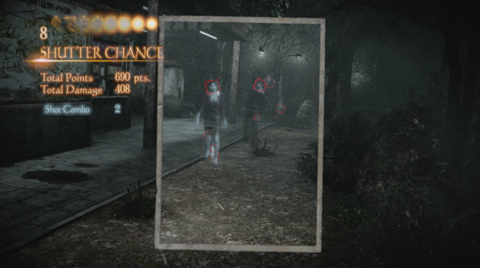Fatal Frame is an eccentric series. Game plots center on horror stories steeped in Japanese myth and tradition, and the main mechanic features using an in-game camera to ward off ghosts. It’s a weird mix, but one engaging enough to earn the franchise a cult following. It’s such a shame, then, that its latest entry is so disappointing. Fatal Frame: Maiden of Black Water has fun, survival horror moments and does an excellent job building its atmosphere. But a paper-thin narrative and clunky, frustrating controls drag the experience down.
The story takes place in a small rural Japanese town and on Mt. Hikami, a neighboring landmark that has become a popular place for young women to commit suicide. The mountain hosts a number of dilapidated buildings, including a shrine that in ancient days was filled with pious maidens. Unsurprisingly, everything is haunted.
You spend most of the game controlling Yuri, a young woman with the ability to see dead people and view their memories. She decides to find people who have gone missing on Mt. Hikami and lead them back home. Also unsurprisingly, her altruism uncovers the area’s greatest ghost story. The two other playable characters--a miserable young man with equally miserable facial hair named Ren and a troubled teen named Miu--also get caught up in the mystery, with their own specific problems to resolve because of it.

If you’re familiar with Japanese horror flicks, or have at least seen The Ring, then you know what to expect in terms of pacing; this brand of cinema tends to reveal mysteries bit by bit through increasingly gross and shocking events. But Maiden of Black Water front loads most of its intrigue, blowing major plot twists within the first few chapters and destroying any sense of dramatic pacing. Discarded notes and journal entries scattered throughout each area add color to events, but don't yield anything new; you're exposed to enough heavy foreshadowing earlier on that everything is predictable. Much of the middle is a tedious slog, as you retread previous areas wringing little revelatory substance.
It doesn’t help that characters have punishingly little depth. It’s hard to care about anyone in Maiden of Black Water because nobody acts like they care, either. Lifeless lines are delivered through lifeless acting, and the story gives little indication of genuine affection between its characters. Every line is delivered in the same stoic, stone-faced way. There's barely any progression within relationships, no reason to believe a young woman looking for her mother actually gives a damn about her mother or that Yuri's guardian cares about Yuri. Yuri's aforementioned decision to find the missing is not given much context; she just does it, apparently with no motivation given. Character decisions like this are abrupt with no drama or emotion behind them; they are only things that need to happen to further plot. I found it difficult to empathize or care about these people, because Maiden of Black Water tells you these relationships exist but doesn't bother to show you why they exist, or why they matter.

For the most part, Maiden of Black Water tells you exactly where you need to go and keeps you firmly on the path to getting there. But the game is at its best when it sets you down in an area and lets you explore on your own. The graphics aren't the sharpest, but the game does an amazing job of setting a sorrowful tone and creating an atmosphere of simmering tension. Abandoned shrines sit coldly under canopies of dark, dripping leaves, shadows playing along decrepit wooden beams. Apartments are bathed in the dull golden glow of lamplight, creating a sense of warmth but also emptiness. Watching my character slosh through stagnant ponds of dirty water made me feel uneasy; watching her flashlight play off gravestones and ancient, broken stone lanterns made the setting feel chillingly real.
These areas are also complicated. Exploring an abandoned building often involves discovering which doors are locked, searching for keys, creeping through soggy basements and running along rickety porches. These multi-leveled structures are playgrounds for ghosts and the imagination, and poking into every nook and cranny sells the sense of desolation and destruction. You really feel like you’re in a remote area of Japan, a place forgotten by time and haunted by history. It’s a marvelous setting for a story, and exploring it unfettered by main directives is a delight.
Maiden of Black Water's characters often talk about feeling empty, and the game frequently shows people committing suicide. The story briefly touches on depression, self-hatred, and mental illness--heavy subjects that are difficult and painful to deal with. However, the game treats suicide almost like window dressing to plot, and includes the rest as character motivation without explanation. It’s disheartening and uncomfortable to see these problems treated with no thoughtfulness or depth.


Taking a photo with your Camera Obscura--Fatal Frame's ghost camera--requires holding the GamePad upright in front of you, aligned as symmetrically as possible with your TV screen, and entering camera mode. Once in camera mode, the TV screen becomes less important as you use the GamePad to identify ghosts’ weak points. Tap a button to snap a photo, which stuns them for a half a second. Then it’s a game of cat-and-mouse as you move to keep out of reach while waiting for your camera to reload for another photo. As you snap away, your camera absorbs Spirit Power, which can be used to trigger a Fatal Frame attack and take several photos in rapid succession without needing to reload. You can stick with landscape shots or flip the GamePad for a portrait shot to get more ghosts in frame.
The camera is also upgradeable. At the end of a chapter you’re awarded points based on the quality of your paranormal photos. These points can be spent on upgrading the camera and its different lenses, the latter of which have special effects like stunning ghosts for 10 seconds or inflicting more damage. Knowing customization is an option inspired me to take care when choosing my photo angles and work quickly when dispatching poltergeists. It’s gratifying to rack up tens of thousands of points and then spend them on creating a powerful exorcism machine. Despite an uninteresting story and choppy pacing, tricking out your camera makes you feel like you’re genuinely achieving something through gameplay.
Fatal Frame is an obvious candidate for an installment on the Wii U because camera controls seem like a perfect fit for the GamePad controller. Having a piece of equipment in your hands that literally feels like a camera is a boon to Maiden of Black Water’s tone and immersion. As you wander through rainy forests and abandoned structures, you'll frequently stumble upon specters minding their own business--or they’ll pop out of nowhere and throw themselves in your face. For the ghosts that don’t acknowledge you, a quick snap will do. For those that want to harm you, it’s time to play quick-draw with your shutter.
However, controls aren’t always reliable. Hairpin precision is essential for getting rid of spirits quickly, but this need can get in the way; if your GamePad isn’t exactly lined up with the screen, you’ll run into trouble if you have to turn more than 90 degrees to get a ghost in-frame. The most powerful ghosts move fast, necessitating lightning-fast reflexes, and sometimes I could swing the GamePad around 180 degrees with no problem, grabbing a shot of the spirit behind me just before it attacked. But other times the gyroscope would just stop working, and I’d find myself waving the controller around in wild desperation. In these cases, you may have to back out of camera mode, take a second to reorient your character, then hop back in camera mode. Almost always in these instances, ghosts attacked during the time I needed to readjust and I ended battles feeling more frustrated than accomplished.

It also takes a painfully long time to turn around, and basic movement is so slow as to feel unnatural. The sheer length of time required to spin on the spot and face a ghost will frequently result in taking damage before you even have the chance to take aim. Some ghosts move pretty quickly, and being so sluggish makes it feel like you’re never adequately prepared enough to defend yourself. It’s aggravating enough to discourage getting into “fights” with them to begin with. Again, you need to keep that GamePad completely upright when you first enter camera mode; even the slightest angle of variation when you start can change the way motion controls read your movements, contributing to disorientation. Additionally, the right trigger has too many commands mapped to it: you use it as your compass, to pick up objects, to inspect pieces in the environment, to cycle through text boxes... Sometimes when you’re standing near an object and press the appropriate button to pick it up, the game will summon a trace--a white human shape that illuminates the path you need to take--instead. It’s another control element adding to frustration.
The most dramatic parts of gameplay are "boss battles” where you take photos of more powerful ghosts. Running around a room and then frantically whipping out the camera to get a demonic priest off your back can be exhilarating--when the controls behave. If there are too many ghosts on screen, the frame rate tends to chug, making everything scary in an entirely different way. Additionally, you can use healing items in battle, but only by calling up the pause screen, which takes much of the drama and urgency out of battling away ghosts. It gives you no incentive to play things safe and protect yourself, as you can always just take a break from battle and load up on purifying water.
Fatal Frame: Maiden of Black Water is a well-intentioned addition to the Wii U’s mostly family-friendly library and does an excellent job of transporting you to another place and time. That’s about it, though. Its story and characters are not compelling, and the GamePad-as-camera controls are frequently unreliable. These prevent the game from attaining any real sense of excitement or drama. With too much out of sync--from wildly variable handling to the way you use items to the unconvincing character relationships--Fatal Frame: Maiden of the Black Water isn't anything more than a mediocre experience.